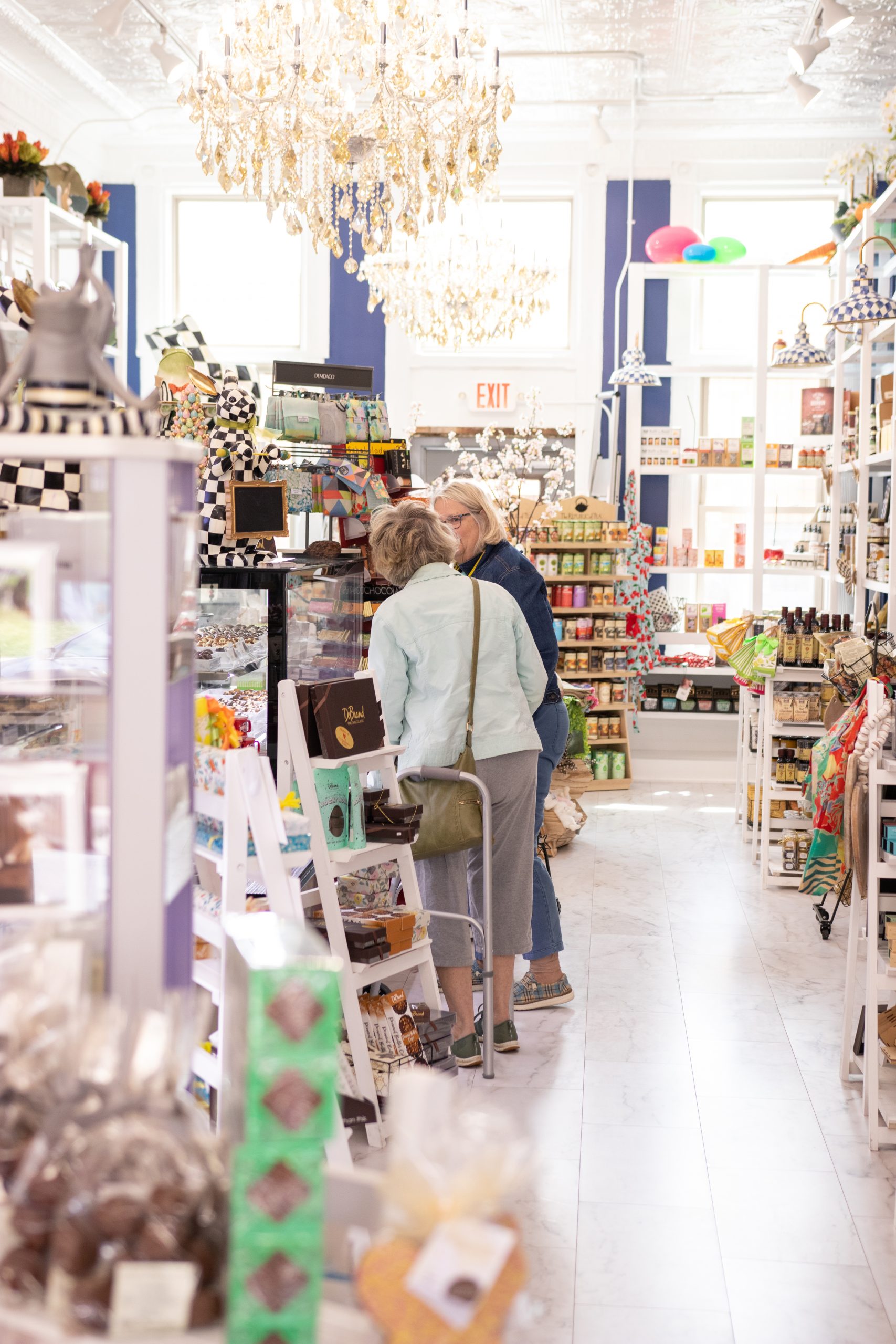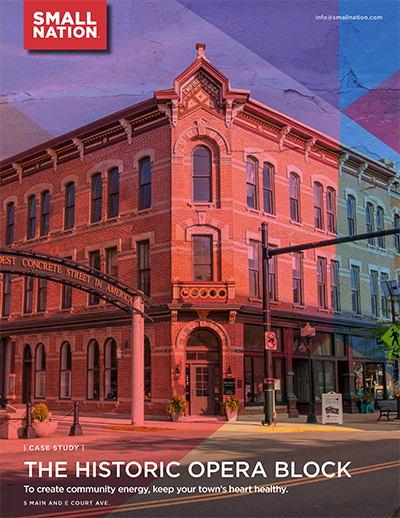
Fortunately, there is always hope-with collective effort, even seemingly lost causes can be brought back to life.
At Small Nation, we believe that buildings aren’t just static, inanimate structures. The architecture of a town and the quality, design, and intent of its public spaces have a direct impact on human interaction, mood, and behavior.
Great spaces become a catalyst for additional greatness. They engage day to day activities and inspire new ways of thinking. People want to be inside of them and admire them. They attract those who dream big dreams and take action to create great things themselves. Forward-thinking businesses, entrepreneurs, creatives, doers, and makers gravitate to places that are inspirational and have stories to tell. Run-down environments lead directly to less-thandesirable actions and, eventually… apathy or desertion. These are, as we all know, the things that inevitably lead to a downtown area’s decline.
When people watch a building in their town fall apart, it becomes a symbol of the spirit of the place. And that’s exactly what happened at The Historic Opera Block.
The Heart of the City
Designed by architect David William Gibbs in 1880, the Opera Block and Empire Block buildings served as the beating heart of our community for nearly a century. Encompassing nearly an entire city block, the structure housed many merchants throughout the years who supplied Bellefontaine with everything from groceries and dry goods, to the post office, newsstand, and furniture.
A Grand Opera house once stood behind the current Opera Block and Empire Block buildings, offering performances by some of the biggest names of the time. The Chicago and Pittsburgh Symphonies once entertained the Bellefontaine community in the Grand Opera House, as well as John
Phillip Sousa, Buffalo Bill Cody, Kollar and Herman, and Harry Houdini. The Grand Opera House continued operations for 33 years, closing its doors in 1913. In 1917 it became a movie theater until the theater was torn down in 1956. After that, the block underwent many changes.
Merchants continued serving the community from the building, but the majesty of the structure soon began to lose its luster. Like many historic buildings in small towns, the upper floors were no longer utilized due to the cost of energy and egress improvements, leaving only street-level
usage. This often happens as a good-intentioned way to save on a building owner’s balance sheet, but the practice has long-term impacts, both on the value of the asset and on the community as a whole.
Because the unused upper floors of The Opera Block building remained dark, empty, and out of mind for decades, they began to fall into decline. Parts of the roof had blown off and were not repaired, which led to structural damage on the floors below. Squatters had taken up residence in the building, and there were illegal activities that were well hidden for quite some time. These forgotten spaces led to the second and third floors of the Opera Block building being condemned by the city for health and safety issues prior to our purchase of the property.
A grand structure that was once the beating heart of our city had, through neglect, become a source of downward momentum and decay.
Remedy and Repair
Small Nation purchased The Historic Opera & Empire Blocks in 2021 for $310,000. The three-story, 10 storefront building encompasses over 40,000 square feet of usable space, with 20,000 square feet of office space on the second and third floors.
The biggest thing to know about the redevelopment of historic spaces is, you just never know what you’re going to run into. Each building has unique structural considerations and has lived through different owners, uses, and periods of upkeep or decline. The Opera Block’s issues and surprises were numerous.
In order to remove the building from condemned status, the first thing the Small Nation team had to do was roll up our sleeves, grab a shovel, and get rid of mountains of trash. Sixty-two 40-yard dumpsters of trash and debris were removed from the property. That’s almost 375 tons of junk that stemmed from decades of neglect.
It took six months just to clear out the building and make sure it was safe before any cosmetic upgrades could begin. $200,000 was immediately invested to stabilize the roof, deal with structural issues, and the interior plaster and lath just to make the building safe to work and inhabit. Headers were rebuilt, basements were reinforced, and sump pumps were added to make sure there would be no additional water issues. New plumbing and HVAC systems had to be installed because the existing ground-level tenants did not have heat or hot water at times.
During this process, the Small Nation team had regular meetings with the city and fire department, working collaboratively to bring this huge project out of condemned status so we could push forward with our vision for the Opera Block’s future.
Once the safety issues were remedied and the condemned status was removed, we got to work immediately on phase two of bringing the building
back to life.
Re-envisioning and Redevelopment
When envisioning what the Opera Block could become, the team was strategic about the mix of potential tenants for the street-level spaces. Our ultimate goal was to attract a mix of retail, professional services, and creative or “experience” businesses that individually served our community and created a destination experience for out-oftown visitors.
When recruiting we ask: Will this tenant add to the foot traffic of other businesses? Will they provide a product or service that will keep residents’ money in town rather than leaving for something the bigger town next door offers and we do not? Is it unique — not a carbon copy or repeat of
something people can find elsewhere? Will it animate the streets in the evening as well as in daytime hours? Will the tenant mix add to the number of hours a visitor stays in our town? Will it add to what our target visitor wants to buy or experience?
Our approach to filling every open space with our target tenant type is to create environments that will uniquely serve them. For this reason, one of our first priorities was to make updates to the facade and street-level storefronts. The hundred-year-old-bricks were blasted, washed, and repointed. Street-level windows were replaced with new energy-efficient models with copper-coated aluminum; original transom windows were uncovered and repaired, and the window trim and facades that were once painted a flat white were transformed with deep, rich, historically relevant colors that complemented the building’s original architecture details.
The Opera Block Today
The renovation of the Opera Block will not only further invigorate Bellefontaine’s community spirit, it will also amplify this town of 13,000’s status as a growing regional retail destination.
Today, the shops at the Opera Block include a coffee shop, home decor, boutiques, a chocolate and gourmet foods store, a small event venue, and even an axe-throwing destination. One of the upper floors features deluxe office suites supported by the services at Build Cowork+Space. The state of a town’s architecture can be an indicator of its success or decline, reflecting the spirit and culture of its people. If city leaders, lenders, and building owners do not make decisions that support the strategic elevation of their architectural assets and environments, there are no other economic development tactics that will fully succeed in attracting new business and residents.
People want to work and live in spaces that are alive and thriving. Investing in the strategic redevelopment of historic structures helps support the economic and spiritual health of an entire community.











